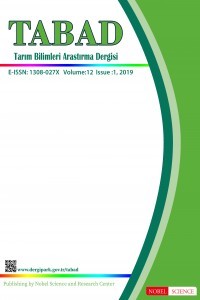Volatile components of Stachys cretica subsp. anatolica Rech. F., Ann. in Koçtepe province of Isparta, Turkey
Stachys cretica subsp. anatolica, SPME, GC-MS, volatile oil
___
- Baydar, H. 2009. Tıbbi ve Aromatik Bitkileri Bilimi ve Teknolojisi. Süleyman Demirel Üniversitesi Ziraat Fakültesi, (Genişletilmiş 3. Baskı) Yayın No: 51, 348 s.
- Davis, P. H. 1982. Flora of Turkey and The East Aegaen Islands, 7, Edinburg University Press.
- Faydaoğlu E., Sürücüoğlu M.S. 2011. Geçmişten Günümüze Tıbbi ve Aromatik Bitkilerin Kullanılması ve Ekonomik Önemi Kastamonu Üniversitesi, Orman Fakültesi Dergisi, 11 (1): 52 – 67.
- Garnier, G., Bezanger-Beauquesne, L., Debraux, G. 1961. Ressources Medicinales de la Flore Fransais, Cilt 2, Uigot Frerer Ed, Paris.
- Goren, A. C. Piozzi, F. Akcicek, E. Kılıç, T. Carıkcı, S. Mozioğlu, E. Setzer, W. N. 2011. Essential oil composition of twenty-two Stachys species (mountain tea) and their biological activities. Phytochemistry Letters, 4: 448-453.
- Güner, A. 2012. Türkiye Bitkileri Listesi, Damarlı Bitkiler. Nezahat Gökyiğit Botanik Bahçesi Yayınları, 1290 s, İstanbul.
- Kalaycıoğlu, A., Öner, C. 1994. Bazı bitki ekstraktlarının antimutajenik etkilerinin Amest-Salmonella test sistemi ile arastırılması. Tr. Botany, 18: 117- 122.
- Koyuncu, O. 2005. Geyve (Sakarya) ve Çevresinin Floristik ve Etnobotanik Açıdan İncelenmesi, Doktora Tezi, Osmangazi Üniversitesi Fen Bilimleri Enstitüsü.
- Özkan, G., Göktürk, R.S., Ünal, O., Çelik, S. 2005. Determination of The Volatile Constituents and Total Phenolic Contents of Some Endemic Stachys Taxa From Turkey. Chemistry of Natural Compounds, 42:172.
- Öztürk, M., Duru, M. E., Aydoğmuş-Öztürk, F., Harmandar, M., Mahliçli, M., Kolak, U., Uluben, A. 2009. GC-MS Analysis and Antimicrobial Activity of Essential Oil of Stachys cretica subsp. smyrnaea. Naturel Product Communications, 4 (1): 109-114.
- Sarıkaya, A.G. 2018. Chemical constituents of the volatile oils of Stachys cretica sybps. anatolica and Stachys lavandulifolia from Turkey. Applied Ecology and Enviromental Research, 16(3): 3079-3086.
- Seçmen, Ö., Gemici, Y., Görk, G., Bekat, L., Leblebici, E. 2011. Tohumlu Bitkiler Sistematiği, 9. Baskı, 361 s. Ege Üniversitesi Basımevi, İzmir.
- Steinmetz, E. F. 1954. Materia Medica Vefetabilis, Cilt 1-2, Amsterdam.
- Weiss, E.A. 1997. Essential Oil Crops. The Journal of Agricultural Science, 129 No:121-123.
- Başlangıç: 2008
- Yayıncı: Nobel Bilim ve Araştırma Merkezi Limited
Köylünün Alternatif Tarım ve Ulaşım Aracı: “Modern Eşek Patpat”
Batı Akdeniz Bölgesi Yörüklerinin Bitkisel ve Hayvansal Üretim Faaliyetleri
Yeni Nesil Bitki Islahı Yöntemleri (Moleküler Bitki Islahı) Bazı Avantaj & Dezavantajları
Yusuf ŞAVŞATLI, Fatih SEYİS, Mustafa AKBULUT, Muhammed ÇATAL, Nalan BAKOĞLU
